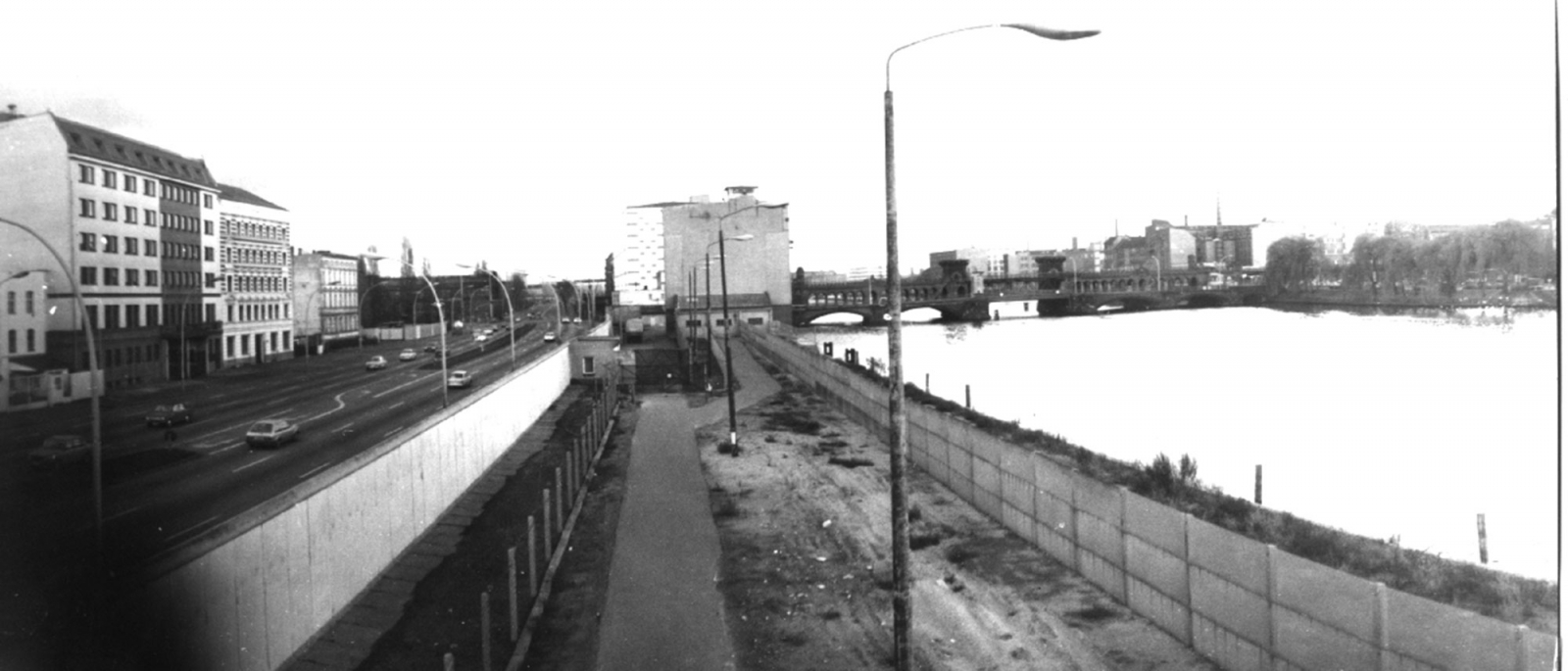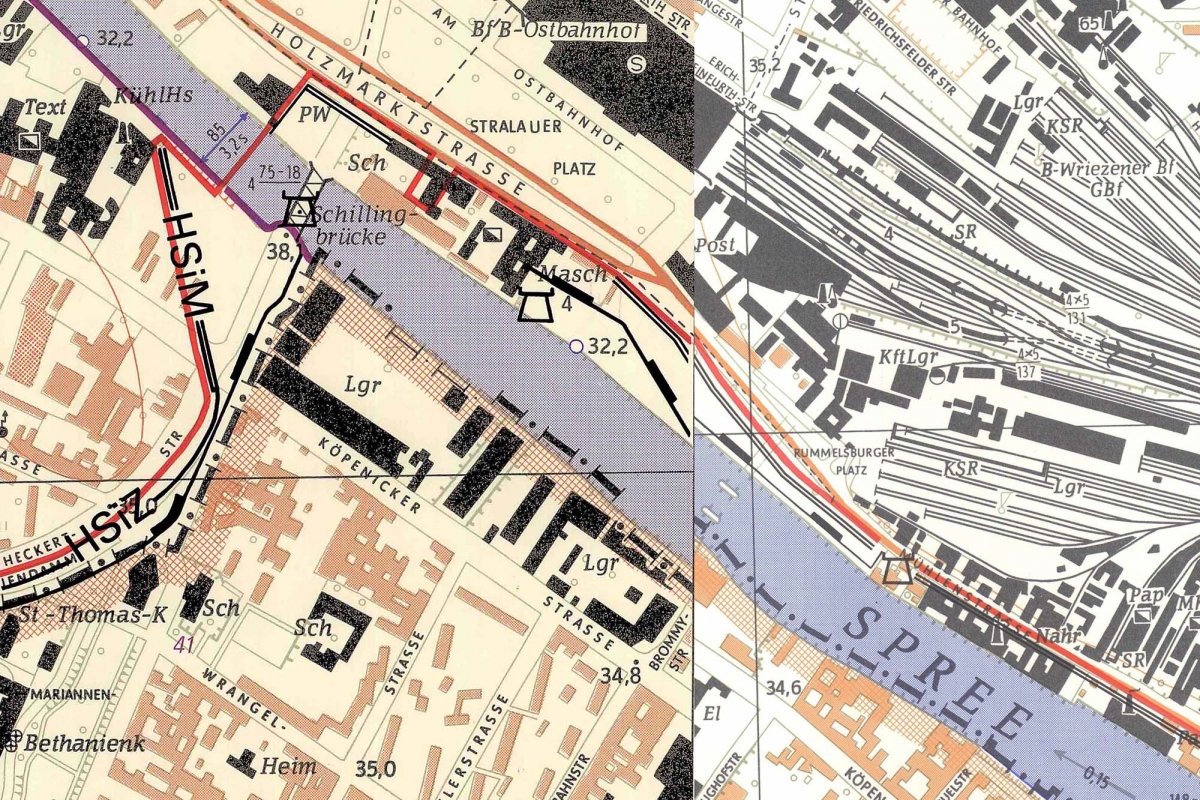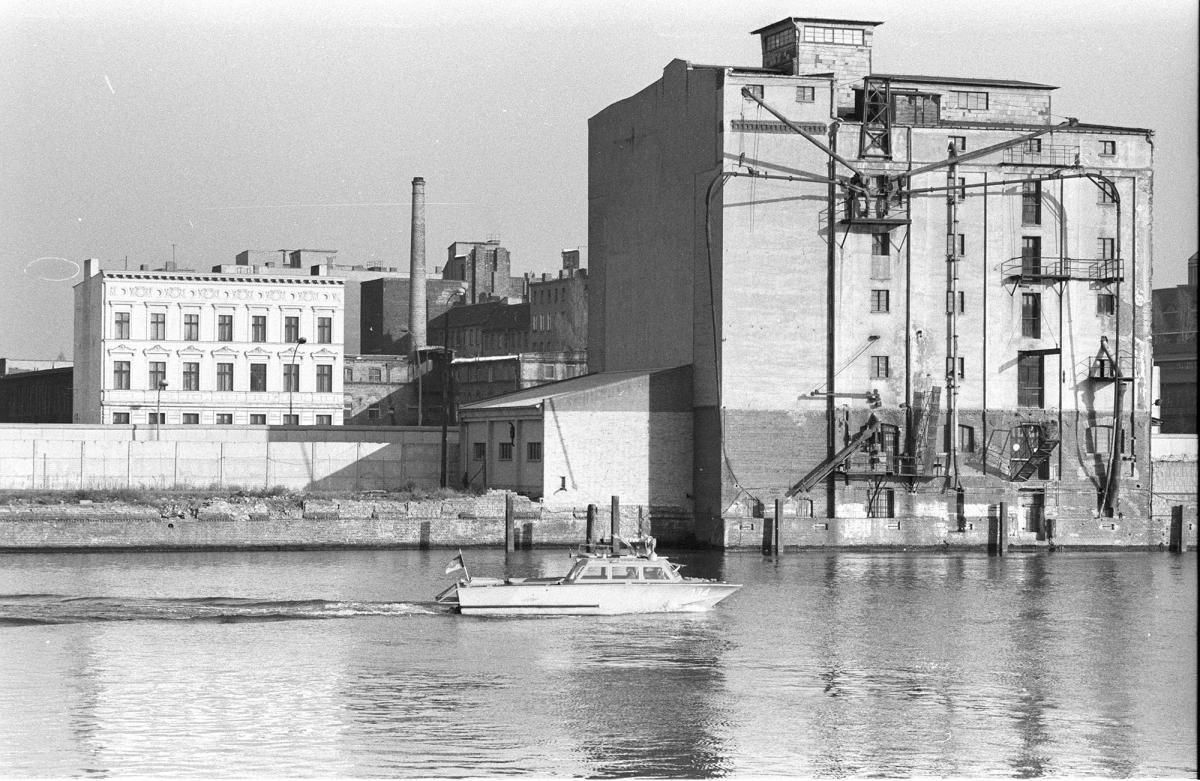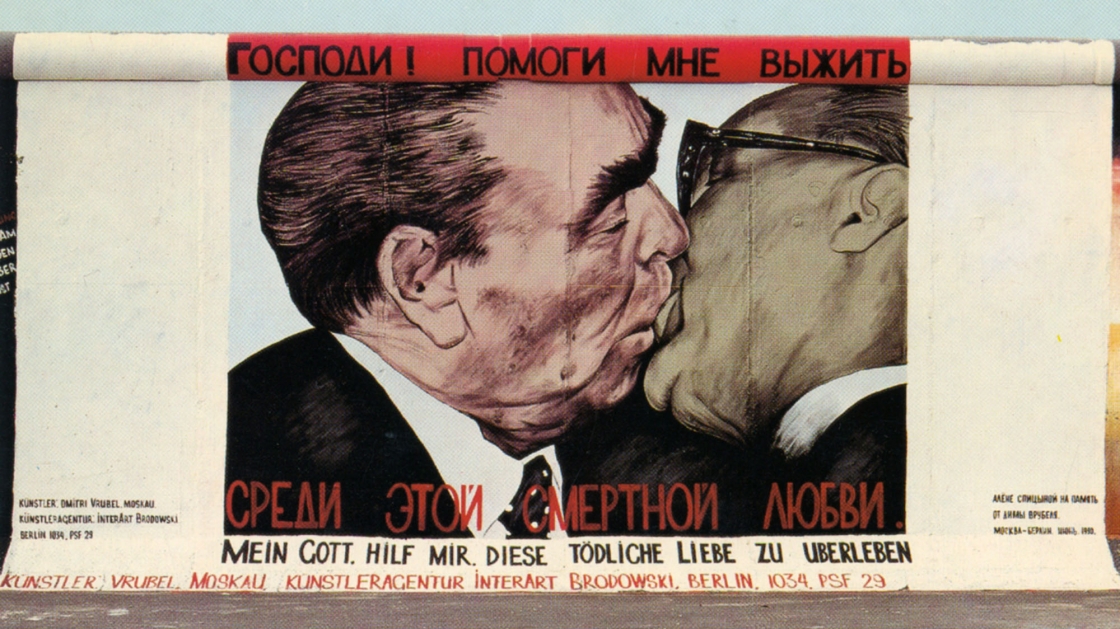The Berlin Wall on Mühlenstrasse: 1961-1989


Detail from a service map of the border troops from 1986, showing the course of the border as it stood in 1986 © Berlin Wall Foundation
The Early Border Fortifications
The border fortifications at this site had special significance. When the Wall was built on August 13, 1961, the River Spree between Friedrichshain and Kreuzberg became part of the border strip. The entire width of the river here belonged to East Berlin. West Berlin territory began at the riverbank on the Kreuzberg side. Thus the East Side Gallery exists today on a section of former Hinterlandmauer, the inner wall that once faced East Berlin.
In addition to this topographical distinction, the border grounds here exhibited another unique feature: With Mühlenstrasse serving as a “protocol route” for high-ranking visitors to the GDR, the inner wall here was visible to all. It resembled the “Border Wall 75” that usually faced West Berlin. The 3.5-meter-high wall elements were meant to obstruct the view of the death strip.
The historic relics on Mühlenstrasse give an impression of how increased security measures and ongoing expansion of the Berlin Wall made the border increasingly invincible. Building structures on the river embankment were gradually removed in the 1970s to provide GDR border soldiers with an unobstructed “view and clear line of fire.” The entire area was razed in 1977, leaving only the Mühlenspeicher, a large warehouse on the harbor grounds. The intact urban infrastructure here was completely destroyed by the GDR border fortifications. A section of the inner wall made of the characteristic cinder blocks from 1961 still exists here and is one of the few preserved examples of the first generation of the Wall.
It can be seen today at the “Stralauer Platz” entrance to the East Side Gallery. Other historic relics, such as an original lantern from the “front end security,” are found near the Mühlenspeicher warehouse.

A patrol boat in front of Mühlenspeicher. Photo by Edmund Kasperski
Deaths
Immediately after 13 August 1961, people tried to flee through the Spree to the West Berlin bank. With Udo Düllick (5 October 1961), Werner Probst (14 October 1961), Anton Walzer (8 October 1962), an unknown fugitive (19 January 1965) and Manfred Weylandt (14 February 1972) at least five people died in the border area between Oberbaumbrücke and Schillingbrücke. They were shot by GDR border guards, died under fire from hypothermia or exhaustion.
Dramatic incidents also occurred on the Kreuzberg side of the river when children fell into the water while playing. They lost their balance or slipped and and were unable to get out of the water. By 1975, four children - Cengaver Katranci (30 October 1972), Siegfried Kroboth (14 May 1973), Guiseppe Savoca (15 June 1974) and Cetin Mert (11 May 1975) - had drowned on the Kreuzberg Gröbenufer (now May-Ayim-Ufer) and near the destroyed Brommy Bridge. The boats of the GDR border troops were forbidden to sail so close to the West Berlin bank without explicit orders. West Berlin rescue workers could not intervene because of the danger that the border troops might shoot at them. The West Berlin Senate refused to erect a fence because it feared it would mean recognising the border. It was not until October 1975 that the West Berlin Senate and the GDR government made arrangements for rescuing West Berliners in border waters. For this purpose, rescue pillars were installed at the water border between East and West Berlin, at which the GDR border guards could be informed of an accident. Another boy, Andreas Senk (13.9.1966), died already in 1966. His fall into the Spree had been noticed too late.
East Berlin
Udo Düllick (1936-1961)
Udo Düllick drowned in the Spree on October 5, 1961. He was fleeing near Oberbaum Bridge when he came under fire.
Read his full biography via the "Chronicle of the Berlin Wall" website here.
Werner Probst (1936-1961)
Werner Probst was shot and killed on October 14, 1961 while trying to flee in the Spree at the sector border between Berlin-Friedrichshain and Berlin-Kreuzberg.
Read his full biography via the "Chronicle of the Berlin Wall" website here.
Anton Walzer (1902-1962)
Anton Walzer died from a shot to the back of his head while he was fleeing in the Spree near Oberbaum Bridge on October 8, 1962.
Read his full biography via the "Chronicle of the Berlin Wall" website here.
Unknown victim (19.1.1965)
A man, roughly 30 years old, drowned while trying to flee across the Spree. His strength failed him just shortly before he reached the riverbank. He has never been identified.
Read about the escape attempt via the "Chronicle of the Berlin Wall" website here.
Manfred Weylandt (1942-1972)
Manfred Weylandt drowned after being shot in the back of the head while trying to flee across the Spree near Schilling Bridge on February 14, 1972.
Read his full biography via the "Chronicle of the Berlin Wall" website here.
Philipp Held (1942-1962)
Philipp Held drowned in April 1962 while trying to flee; probably at the sector border between Berlin-Friedrichshain and Berlin-Kreuzberg in the Spree River.
Read his full biography via the "Chronicle of the Berlin Wall" website here.
Hans-Joachim Zock (1940-1970)
Hans-Joachim Zock drowned in November 1970 at the sector border between Berlin-Friedrichshain and Berlin-Kreuzberg in the Spree River.
Read his full biography via the "Chronicle of the Berlin Wall" website here.
Ulrich Krzemien (1940-1965)
Ulrich Krzemien drowned on March 25,1965 in the Spree River near Osthafens at the sector border between Berlin-Kreuzberg and Berlin-Friedrichshain.
Read his full biography via the "Chronicle of the Berlin Wall" website here.
Heinz Müller (1943-1970)
Heinz Müller was shot dead on June 19, 1970 near the Schilling Bridge
at the sector border between Berlin-Kreuzberg and Berlin-Friedrichshain.
Read his full biography via the "Chronicle of the Berlin Wall" website here.
West Berlin
Andreas Senk (1960-1966)
Six-year-old Andreas Senk drowned on the morning of September 13, 1966 when a playmate of the same age pushed him into the Spree.
Read his full biography via the "Chronicle of the Berlin Wall" website here.
Cengaver Katrancı (1964-1972)
Eight-year-old Cengaver Katranci drowned in the Spree on October 30, 1972. He was playing with friends at the Gröbenufer embankment in Kreuzberg when he lost his balance and fell into the water.
Read his full biography via the "Chronicle of the Berlin Wall" website here.
Siegfried Kroboth (1968-1973)
On the morning of May 14, 1973, five-year-old Siegfried Kroboth was playing with a friend on the riverbank near the war-damaged Brommy Bridge in Kreuzberg when he fell into the water and drowned.
Read his full biography via the "Chronicle of the Berlin Wall" website here.
Guiseppe Savoca (1968-1974)
Six-year-old Guiseppe Savoca drowned while playing with a friend on the Gröbenufer embankment in Berlin-Kreuzberg on June 15, 1974. He had been fishing with a stick when he lost his balance and fell into the water.
Read his full biography via the "Chronicle of the Berlin Wall" website here.
Çetin Mert (1970-1975)
Cetin Mert drowned in the Spree while playing on the Gröbenufer embankment on May 11, 1975. He was trying to retrieve his ball from the water when he fell into the river.
Read his full biography via the "Chronicle of the Berlin Wall" website here.
